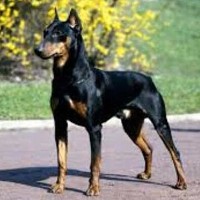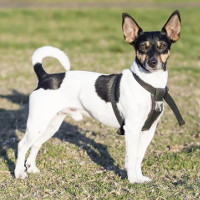Appearance of the American Rat Pinscher
|
| The American Rat Pinscher is a mix of a medium-sized dog and a toy-sized dog, with the resulting offspring generally classified as small dogs. There are no uniform colors or markings, but generally the dog will be black with white markings. The coat is short and fine. The American Rat Terrier generally has a short, smooth, dense and glossy coat. The American Rat Terrier is a mixture of several colors, most rat terriers have white markings on the body. The Miniature Pinscher also has a short, fine, smooth coat. The breed's primary colors are black, red and rust. Expect your American Rat Pinscher to be a mix of both. |
Temperament of the American Rat Pinscher
|
| The American Rat Pinscher is described as an excellent apartment dog for active families. To get a good idea of the temperament expected, let's explore the personalities of the parent breeds. The American Rat Terrier is highly intelligent, but can be stubborn and often dislikes strangers. It has a reputation for being an excellent pet, and is known to follow its owner around all day long. The Miniature Pinscher is known for being very feisty and active. They are also quite fearless. The Miniature Pinscher is very curious, and its hunting instinct can lead it to chase small animals or jump on small objects. Expect the American Rat Pinscher to be curious and intelligent, even mischievous at times. Training and socialization should start early. Miniature Pinschers can be quite stubborn, so it's important to be firm and consistent with your American Rat Pinscher. |
Needs and activities of the American Rat Pinscher
|
| The American Rat Pinscher is a very active dog. It's a good idea to make sure it gets a moderate amount of exercise, to avoid the dog getting into mischief around the house. Both parent breeds are described as inquisitive and very active, so it's best to spend an hour or more exercising with your dog. Otherwise, it can become destructive as a way of releasing pent-up energy. Both parent breeds tend to chase small animals, and they don't do well on a leash, so be careful when taking your American Rat Pinscher out. It's also not a good idea to leave him in a fenced-in yard for long periods. The American Rat Terrier is known to dig under fences, so it's not inconceivable that the American Rat Pinscher won't do the same. American Rat Pinschers are also known to climb fences, so leaving the American Rat Pinscher in a fenced area for a long period is not a good idea. One expert has said that a good dog is a tired dog, so this could be the key to keeping your American Rat Pinscher active and out of mischief. |
Maintenance of the American Rat Pinscher
|
| The American Rat Pinscher is a combination of two very easy-to-care-for breeds. Brushing once a week with a soft bristle brush or even a grooming glove keeps the American Rat Pinscher's coat smooth and shiny. Bathe your American Rat Pinscher only when necessary. Some parents of Miniature Pinschers simply take a damp washcloth and rub it over their dog, paying attention to the eyes and ears. This can be done every few days to keep your American Rat Pinscher clean and healthy. Brushing his teeth two or three times a week will help prevent tooth decay and bad breath, however, daily brushing is optimal for preventing gum disease. Trim your American Rat Pinscher's nails at least every two weeks. A general rule of thumb is that if you can hear your dog's nails clicking on the floor, it's time to trim them. It's important to start a grooming regime with your American Rat Terrier at an early age so that he gets used to it. |









 English (United Kingdom)
English (United Kingdom)